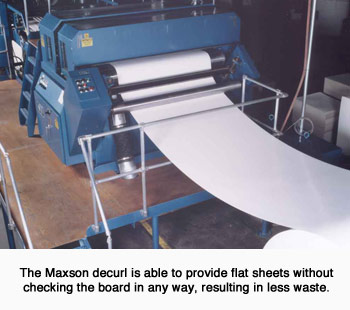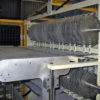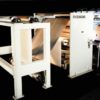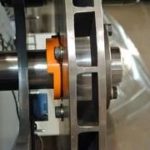These days, market advantage is achieved and maintained by quickly identifying industry technological advances and swiftly implementing them. MOD-PAC, a Buffalo, NY supplier of specialty paperboard packaging, growing at twice the pace of the industry average, is a case-in-point.
In existence since 1881, MOD-PAC became a part of the Astronics Corporation in 1972. Today, the company is ISO 9001 certified and provides a broad product line. MOD-PAC specializes in serving pharmaceutical, healthcare, food, confectionery, automotive, corporate, office and similar industries that rely on package construction for aesthetic and protective purposes. The company serves more than 10,000 customers in more than 22 countries, with a production facility of 300,000 square feet. Dan Keane, President, reported, “our largest market is in the United States, with Mexico in second place and Canada in third place.”
“Our business has two segments,” Keane explained. “First we have customers who participate in a stock packaging program. This includes hundreds of standard packaging designs, which are available for same-day shipment from in-stock inventories. In-house design capabilities permit personalization of graphic designs and imprinting in quantities as small as 50 units.”

MOD-PAC’s Maxson MSL Sheeter
“Unique requirements such as protective structure and product differentiation are answered with the second segment, custom packaging,” Keane continued. Enter, the talents of MOD-PAC’s highly qualified design staff combined with the utilization of advanced computer aided design and manufacturing systems (CAD-CAM). “There was a time when some of this work had to be performed on the outside,” said Kevin Keane, Chairman of the Board. “Since the goal was same-day or 48 hour turnaround for customers in the stock packaging program, and 3-4 days on custom packaging (industry average is one week), we could no longer rely on someone else’s production schedule dictating our own. We are now able to control and maintain exacting graphic quality requirements and turn around a dated item such as a coupon or special offer. We’ve also added a digital prepress unit, including digital plate-making capability and interface between prepress and press departments.”
Bringing the design component inside has given MOD-PAC control over workflow and scheduling. But every area of manufacturing has been scrutinized with an eye to streamlining and expediting production. “We are constantly looking for ways to shorten the cycle time,” Dan Keane says, “Culturally, this production mentality is hard to bring around, but if you’re successful, it will give you a major advantage over your competition.” MOD-PAC is diligent about communicating with and training their employees. They cross-train, as well. That way each employee understands how the workflow interfaces. Says Keane, “We are always looking for the time advantage.”
“For example, one of those areas we needed more control over was acquisition of board stock,” Kevin Keane said. “We realized back in 1995 that we needed a new sheeter. The sheeter that we were using was a weak link in our production process. The vintage 1974 machine we were using was slow and not accurate. It bogged down manufacturing. After doing our homework, we chose the highly recommended Maxson Automatic Machinery Co. MSL Sheeter. It was going to do several things to add to MOD-PAC’s streamlining efforts. The sheeter made available the material needed to print when we wanted it, without having to stock huge amounts of inventory. We also save upcharges for sheeted material.” MOD-PAC uses the MSL Sheeter to get a better handle on quality issues, too. In fact, they were growing so rapidly as a company, they decided they needed more sheeter capacity and this year installed a second Maxson MSL Sheeter identical to the first. MOD-PAC knew that the rugged MSL Sheeter could handle those long runs as well as the short runs.
Presently, MOD-PAC is running 2 shifts per day, 5 days a week. The MSL Sheeter produces up to 20,000 sheets per hour, and will convert up to 8,000 tons of SBS this year. To maximize production efficiency, MOD-PAC is also doing more and more slitting as a result of retrofitting slitters on the first machine and ordering them on the second. This also allows the purchase of larger rolls which establishes a common inventory – another cost savings. With just a few adjustments, changing caliper or width is a simple function on the MSL Sheeter. This flexibility makes it possible to process more short runs economically. “We are installing an additional roll stand on each unit to facilitate faster setup of material for the next job on the schedule,” noted Keane. Fortunately, the overall space economy of the sheeter allows for this expansion without utilizing much more floor area.
Another cost and time saving feature is the web-conditioning unit. If the sheet were not flat, the press would trip off to emergency stop resulting in down time and waste of materials. The decurl unit is able to provide those flat sheets without marring the board in any way. “We’re running 12-30 pt. virgin and recycled board and using all of it, right down to the core,” remarked Keane.
The MSL Sheeter provides a consistently clean cut and since MOD-PAC does a considerable amount of work for pharmaceutical companies, this level of quality is a necessity. The fly knife setting, mounted tangent to the revolver, allows for heavy loading. In addition, the dual motor drive system ensures a sheet length accuracy of ±0.015 inches and a squareness accuracy of ±0.020 inches.
Contributing to the speed is the patented Maxson Airfoil Overlap®. The Airfoil controls the trailing edge of the cut sheet packet at the point of overlap. It guarantees jam-free runs and requires no maintenance permitting speed increases up to 200 fpm on its way to the Series 350 stacking system. In the old days, a downstream jogging and hand-stacking operation was required to get the pile in shape for the printers to receive. “Today, the piles are coming out of the sheeter so perfectly smooth, that further jogging is not necessary,” Keane continued, “and are going directly to the die cutting department or to press.”
MOD-PAC originally established a 48 hour ready-to-draw-on buffer inventory of sheeted stock. However, because of the additional manufacturing capability of the second MSL Sheeter, this inventory has been reduced to a 24-hour inventory. “If there should ever be a breakdown, we know that Maxson will respond and fix the problem within that period of time.” Quick service was one of the features that impressed us when we chose Maxson as a vendor,” Keane observed.
Consistent with overall upgrades are the three Heidelberg machines in the pressroom – none are more than six years old. A five-color CD with double coating and extended drying capabilities was added to a four-color Speedmaster CD with single inline coating station. The latest addition was a six-color perfecting Speedmaster SPC with double coating capability, now making possible metallic colors and special coatings.
Product then flows to one of five new Bobst die cutting machines, cellophane application, folding, gluing, boxing and out the door to the customer.
“This is just in time at its best. We are determined to streamline every detail of our operation without sacrificing any responsiveness. We have a ‘pull-it-through’ attitude about scheduling and production,” summarized Keane.
Reprinted from Board Converting News, 1999






